On 9 September 2015, the very first Boeing 747-400 built, N661US, touched down at Atlanta from Honolulu as Delta Flight 836 for the last time in revenue passenger service. Ship 6301 was the Boeing 747-400 prototype, which was delivered to launch customer Northwest Airlines on 8 December 1989 and came over to Delta with the 2008 merger. There are twelve remaining 747-400s flying with Delta, all of which came over from Northwest. Current fleet planning will have these 747s retired in 2017.
Delta did however, for a brief time, operate the first variant of the 747 family, the 747-100, from September 1970 to April 1977. Only five aircraft were taken on strength with Delta and while the 747-100 was but a short historical footnote in Delta’s history, its legacy looms large to this day with the airline.
In order to understand what the 747 was for Delta at the time, one has to consider that as the 1960s were drawing to a close, Delta was in the midst of transition on several fronts. The first change came with the Southern Transcontinental Route Case of 1961. Prior to deregulation, airlines usually had to make a case for the opening of new services and routes to the Civil Aeronautics Board (CAB). Often these cases consisted of years of deliberation, and politics played a central role in airlines winning favorable rulings from the CAB. In the 1950s, the CAB favored interchange services as a means for airlines to open up new markets without saturating a given route with an excess of seats, harming profitability.
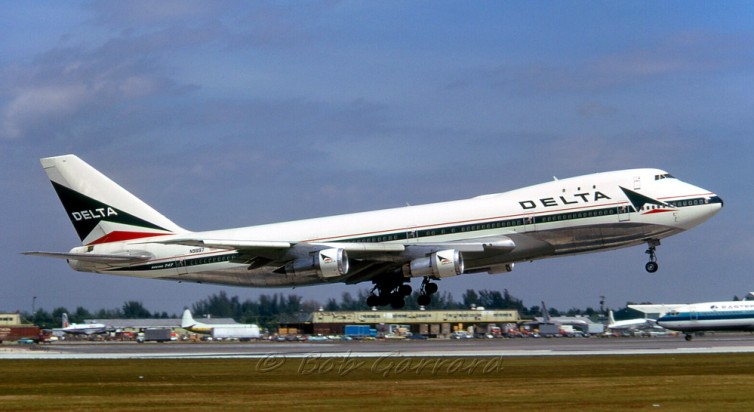
A Delta Boeing 747-100 (reg: N9897) taken in Miami in 1974 – Photo: Bob Garrard
Having a predominantly southeastern U.S.-anchored network, Delta linked up with several other airlines to offer interchange services which allowed it to fly as far west as California. As traffic grew on the interchange services to the west coast, Delta petitioned the CAB to operate the west coast services on its own, and in one of the more historic decisions made by the CAB, both Delta and National Airlines were given route authorities to California from the southeast in what was called the Southern Transcontinental Route Case.
Starting in 1961, the previous interchange agreements were declared redundant and Delta opened up a range of nonstop services to San Diego, Los Angeles, and San Francisco from Atlanta, Dallas, and New Orleans. Within a year, Las Vegas was added, as well as Miami, which for the first time made Delta a transcontinental airline. By 1963, the CAB permitted Delta to carry west coast traffic to its Caribbean destinations via New Orleans and onward to Florida (Orlando and Miami) via Atlanta. In an unrelated decision by the CAB, Delta was allowed to interchange on routes to London from Washington Dulles with Pan American; soon, Delta’s DC-8s were flying to Europe as part of that interchange agreement.
The second and biggest of these changes came with the death of Delta’s founder, C.E. Woolman, on 11 September 1968. In his 1841 essay ’œSelf-Reliance’, Ralph Waldo Emerson wrote that ’œAn institution is the lengthened shadow of one man…all history resolves itself very easily into the biography of a few stout and earnest persons.” From Delta’s founding in 1927 to his death in 1968, no other individual was so closely identified with Delta than C.E. Woolman.
He became the airline’s president and general manager in 1945 and became its chairman of the board only a year before his death. Woolman was beloved by Delta employees. On his 25th anniversary with Delta, the employees presented him with a new Cadillac and, though he owned several other cars, he kept that Cadillac until he died. Though ably succeeded by C.H. ’œCharlie’ Dolson, W.T. ’œTom’ Bebe, and David Garrett, there was no question it was still Woolman’s airline for years to come.
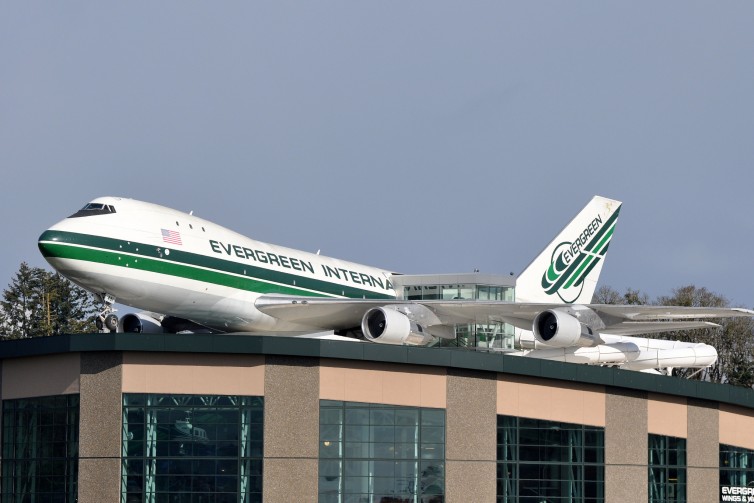
The Boeing 747-100 on the Evergreen Museum used to be Delta’s reg N9896 – Photo: Eric Salard | FlickrCC
The last change that frames the selection and operation of the Boeing 747-100 by Delta was its 1972 merger with Northeast Airlines. Throughout its history, adversity plagued Northeast, which always seemed be hobbled by the CAB with a small network. When Northeast finally did break out of New England in 1968 with new routes to Florida, it ran square into the crosshairs of Eastern, which was the incumbent giant of the U.S. east coast at the time. With Northeast literally going from cash crisis to cash crisis, its New England route authorities soon proved to be ripe for acquisition via merger.
The first suitor was Northwest Airlines in 1969. The CAB approved the merger in 1970 but it would be without some of Northeast’s more attractive route authorities like Miami-Los Angeles. Northwest withdrew its merger offer in 1971 as a result, as its buyout of Northeast was “all or nothing” and not getting the Miami-Los Angeles route authority scuttled the deal. Eastern and TWA then offered merger terms, with Eastern in particular seeing a merger as a way of knocking a competitor out of the New England-Florida market. Those negotiations also fell through, and ultimately it was Delta that came through with a suitable merger offer that also met with the approval of the CAB. On 19 May 1972, President Richard Nixon signed off on the Delta-Northeast merger (since foreign routes were involved).
To recap, there are three events in which to put the context of the Delta’s order of the Boeing 747-100: the Southern Transcontinental Route Case of 1961, C.E. Woolman’s death in 1966, and the merger with Northeast Airlines in 1972.
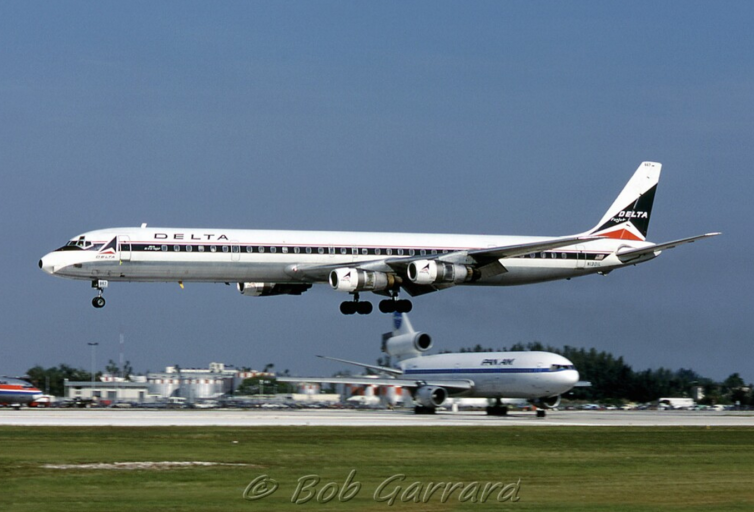
A Delta DC-8-61 taken in 1980 – Photo Bob Garrard
Prior to the launch of the Boeing 747, the ’œbig jet’ of the day was the Douglas DC-8 Super Sixty Series (particularly the -61 and -63) which had surpassed the Boeing 707 in utility and passenger capacity. While the 747’s launch has been historically associated with Juan Trippe and Pan Am, at the time, Boeing was keen on getting one up on Douglas and the 747 was the aircraft that would capture the ’œjumbo’ jet title from the DC-8 Super 61/63.
Delta representatives had visited Boeing to view the progress on the 747 program and were suitably impressed with the aircraft. Despite their favorable views of the 747, it was clear to all of Delta’s management from the outset that the 747 was too much airplane for the airline, which had a predominantly short- and medium-haul route network, with its longer routes suitably (not to mention cost-effectively) served by the DC-8 fleet.
On the other hand, two of Delta’s biggest competitors, Northwest and American, had already placed orders for the 747. Delta’s fellow ’œsouthern transcontinental route’ airline, National, was also expected to place orders for the 747 as well. The writing was on the wall; Delta’s DC-8s were no match for the expected spacious comfort of the big Boeing and the prudent move was to get the 747 as well, even if was just a small number on a temporary basis.
In April 1967, Charlie Dolson, the airline president of the time, announced Delta’s order for three 747-100s for $20 million each, with options for two more aircraft. It marked the very first time that Delta had ordered from Boeing. Preparations were made at six Delta destinations and three alternate cities for operation of the massive jet. When Pan American launched the world’s first 747 passenger services in January 1970, Delta had two representatives aboard the inaugural passenger flight.
While Delta was making preparations for the arrival of the 747, it was carefully considering its future wide-body needs, which were better met by a smaller aircraft in the form of either the Douglas DC-10 or the Lockheed L-1011. Delta’s technical staff liked both aircraft and it was believed the DC-10 was favored, given Delta’s long association with Douglas Aircraft and its extensive use of both the DC-8 and DC-9 in the 1960s. Delta’s close association with Douglas as one of its most loyal customers was the product of a friendship between C.E. Woolman and Donald Douglas.
The DC-3, DC-4, DC-6, and the DC-7 had served in Delta’s fleet. In the 1960s, Douglas had encountered repeated financial and technical difficulties with both the DC-8 and DC-9 programs that resulted in financial losses, ultimately leading to its merger with McDonnell Aircraft in 1967 which effectively put Donald Douglas out of the executive suite. Keep in mind it was the following year that C.E. Woolman passed away.
In a sense, Delta was now a ’œfree agent’ no longer tied to Douglas. Lockheed, eager to put its reputation back on good standing after the issues with the Lockheed L-188 Electra, pulled out all the stops in the Tristar program, engaging potential airline customers aggressively and early on in the Tristar development, resulting in an aircraft that, at least in Delta’s eyes, was practically custom-built for them. Delta did, however, order five DC-10 Series 10s as insurance against the Tristar program when Rolls Royce ran into serious financial trouble during the development of the RB.211 engine used on the Tristar.
BONUS: Requiem For a Trijet Masterpiece – The Lockheed L-1011
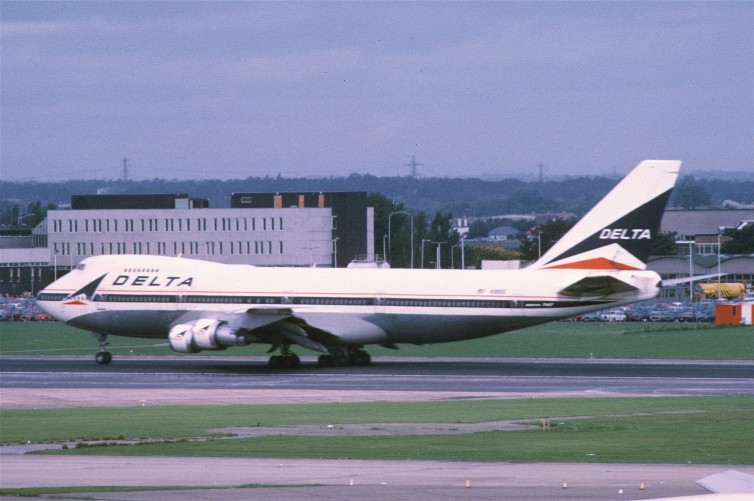
Delta Boeing 747-100 (reg: N9897) taken in 1974 – Photo: Aero Icarus | FlickrCC
Delta’s 747-100 order was fulfilled quickly, with N9896 being handed over to Delta on 25 September 1970; the aircraft arrived in Atlanta to great fanfare on 2 October 1970. N9897 was delivered on 25 October 1970 and N9898 was delivered on 18 November 1970. While Pan American was first to launch 747 services on 22 January 1970 on its New York JFK-London Heathrow route, mostly domestic 747 services were launched in quick succession that year:
25 February: Trans World Airlines, New York JFK-Los Angeles (first domestic 747 service)
2 March: American Airlines, New York JFK-Los Angeles
26 June: Continental Airlines, Chicago-Los Angeles-Honolulu
1 July: Northwest Airlines, Chicago-Seattle-Tokyo
23 July: United Airlines, New York JFK-San Francisco
25 October: National Airlines, Miami-New York, Miami-Los Angeles
25 October: Delta Airlines, Atlanta-Dallas-Los Angeles
21 December: Eastern Airlines, New York JFK-Miami
15 January 1971: Braniff International, Dallas Love Field-Honolulu
By the end of 1970, Delta put the other two 747-100s into service with flights to Chicago, Detroit, and Miami. The options for the two aircraft were exercised the following year with N9899 being delivered to Delta on 30 September 1971 and N9900 arriving on 11 November 1971. While Delta’s 747-100s flew amongst Atlanta, Dallas, Los Angeles, Chicago, Detroit, and Miami, they were also put to use on the Pan Am interchange services between Washington Dulles and London Heathrow. In the space of just over ten years, Delta went from a mostly regional airline anchored in the southeastern United States with some Caribbean routes to a transcontinental airline operating the Boeing 747 with limited interchange services to London.
Never before in Delta’s prior history had it grown so much. But its fleet was quite diverse as a result of the merger of Northeast Airlines – it had twelve different aircraft with eight different engine types in service. In August 1972, Delta had three variants of the Douglas DC-8 in service, three variants of the Douglas DC-9, two variants of the Boeing 727, the Boeing 747-100, the Convair CV-880, the Fairchild-Hiller FH-227, the Lockheed L-100 Hercules for its cargo division, and it was anticipating the arrival of both the Lockheed L-1011 Tristar and the Douglas DC-10! In the interest of reducing the maintenance costs, standardizing operations, and holding down spare parts inventories, the fleet types had to be pared down.
By this point, David Garrett had become president of the airline and it was during his legacy that Delta streamlined its fleet, which gave it record-breaking profits in the late 1970s. Garrett’s primary imperative was fuel savings – the 1973 OPEC oil embargo that followed the Yom Kippur War in the Middle East caused a sharp spike in the cost of fuel.

The Pratt & Whitney JT9D was the first production high-bypass turbofan used on a production airliner – Image: JP Santiago
For smaller markets and the short- to medium-haul flying, Delta standardized on the Douglas DC-9 Series 32. For medium-sized markets and medium-haul flying, Delta standardized on the Boeing 727-200. It had acquired them via its merger with Northeast Airlines and found them to have superior economics to the Convair CV-880s and to some degree even the DC-8s. In addition, the 727-200 used similar Pratt & Whitney JT8D engines as the DC-9.
There were 13 727-200s that came over with the merger with Northeast and Delta wanted more. In March 1972, Delta returned to Boeing once again, this time with an order for 14 727-200s (the order was placed before final approval of the Northeast merger by President Nixon). Boeing even took Delta’s remaining Convairs as a trade-ins on the 727 order. By 1977, there would be 88 727-200s in Delta’s fleet.
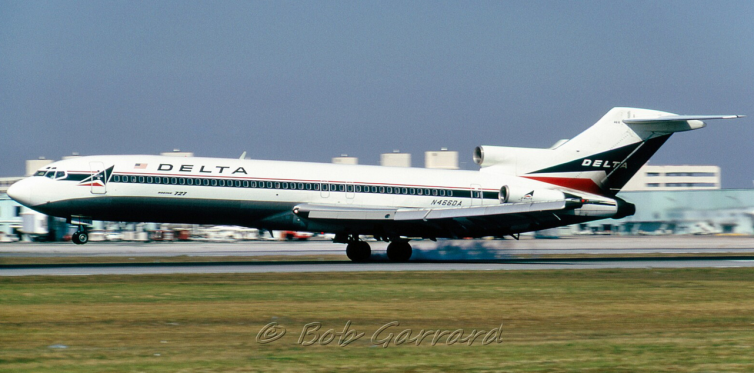
A Delta Boeing 727-200 – Photo: Bob Garrard
Delta’s first experience in working with Boeing on the 747-100 order was so favorable that the airline was eager to work with Boeing quite readily again. The arrival of more 727-200s allowed Delta to dispose of the Convairs and the oldest DC-8s first. While most of the Series 51s and Super 61s were sold off, a sizeable number were kept on for several more years with some of the Super 61s getting the Cammacorp re-engining with the CFM56 to become Super 71s.
By this point it was clear the Lockheed L-1011 Tristar would be the long-haul workhorse of the Delta fleet. The DC-10s were eventually sold off to United. The first Tristar arrived in Atlanta on 12 October 1973, with the first passenger services on 15 December 1973 on the Atlanta-Philadelphia route. By 1974 there were ten Tristars in service, but their spacious underfloor cargo holds meant they carried 25% of Delta’s cargo despite being less than 10% of the fleet.
That allowed the L-100 Hercules transports to be sold off that year. When the Boeing 747-100 was ordered in 1967, it was with the understanding it was too big of an airplane for Delta but it was needed to compete in the marketplace. With the Tristar quickly proving itself, the 747-100’s days were numbered and arrangements were made for the first two 747-100s to be sold off; the last three stayed on just a bit longer until more Tristars were in service. Delta’s last Boeing 747-100 service was flown 23 April 1977 Las Vegas-Atlanta.

Of the five original Delta 747-100s, only the first one, N9896 ’œShip 101’ can still be seen today at the Evergreen Aviation Museum – Image: JP Santiago
The fates of Delta’s five 747-100s:
N9896: Returned to Boeing 1974, leased to China Airlines 1976-1978, operated by Pan Am 1978-1991, then flew with Evergreen International. Preserved at the Evergreen Aviation Museum in 2010 (it’s on the roof as part of the waterpark with waterslides coming out of it!)
N9897: Returned to Boeing 1977, operated by Flying Tiger 1977-1989 (leased to El Al Israel for a year), operated by FedEx 1989-1991, operated by Air Hong Kong 1991-1996, then Polar Air Cargo, now scrapped.
N9898: Returned to Boeing 1975, operated by China Airlines 1975-1976, leased out by Guiness Peat Aviation 1976-1984, operated by Pan Am 1984-1991, operated by Evergreen International starting in 1991 and converted to a water bomber ’œEvergreen Supertanker’, retired with Evergreen’s bankruptcy in 2013. In storage at Pinal Air Park.
N9899: Returned to Boeing 1977, operated by Flying Tiger 1977-1989 (leased to El Al Israel for a year), operated by FedEx 1989-1991, operated by Air Hong Kong 1991-1995, then Polar Air Cargo, now scrapped.
N9900: Returned to Boeing 1977, operated by Flying Tiger 1977-1989, operated by FedEx 1989-1993, operated by Air Hong Kong 1993-1994, operated by Kalitta 1994-2008. Stored at Oscoda, then scrapped 2015.
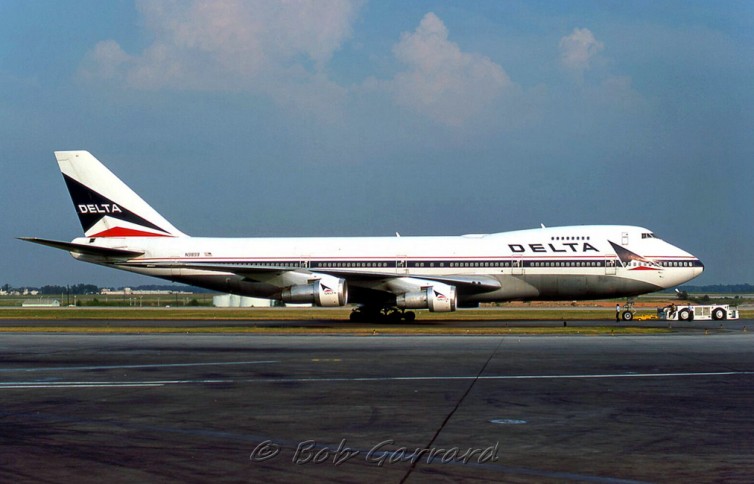
Delta’s reg N9899 in Atlanta in 1976 – Photo: Bob Garrard
As an interesting historical footnote, the first officer on the delivery of Delta’s first Lockheed Tristar was Captain Jack McMahan, who at the time was one of only two men in the United States certificated to fly the DC-10, L-1011, and 747. The other pilot was an FAA examiner. He was asked by a reporter on his impressions of all three wide-bodies – he praised the handling of the DC-10, the overall design of the 747, and the advanced systems of the L-1011. He remarked ’œFlying the three planes is like going out with three sisters. They have the same background but different personalities!’
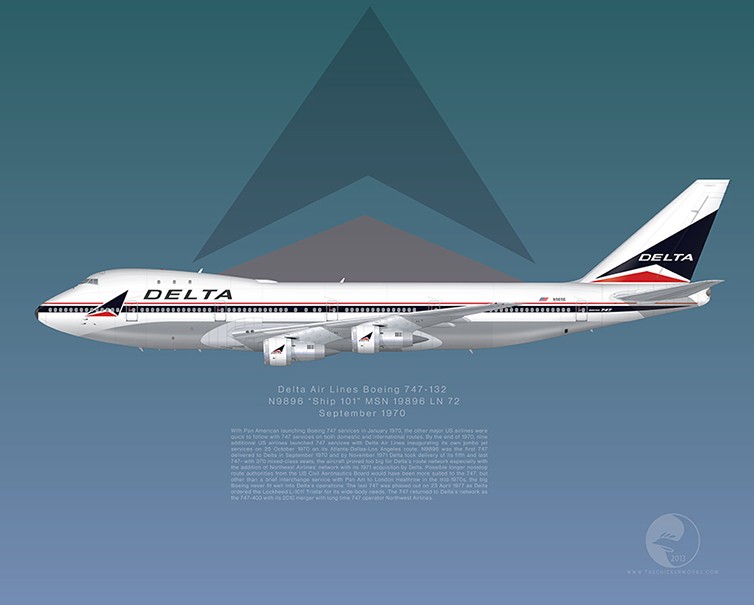

Just wanted to say thanks for an amazing read on Delta today. I found it interesting that it published today, the same day I wrote and published an article about Northeast Airlines being reborn, which is on my site.
I”m a huge nerd when it comes to planes, so it”s always nice to hear more of the back story of things I already knew and new stories which I can share with others!
Cheers!
-Phil
Thanks for the comments, Phil. The story of Northeast Airlines is one that I’ll probably cover in the future and I am working on some Yellowbird 727 prints currently.
Santiago –
Are there any domestic flight that uses 747 today? Anyone flies 747 to Honolulu from mainland US?
JP:
Great story, thanks for the work.
One correction, the Delta 744 fleet is planned to be retired by YEAR-END 2017, not “in 2017”.
They will be around for the entire calendar year 2017!
From your article:
“Current fleet planning will have these 747s retired in 2017.”
Thank you for making the correction,
Dan
Thanks for the clarification, Dan! Will all -400s stay on until then or will they be gradually phased out?
JP:
There will be 8 in the fleet until the end……
Dan
Nice Article, well researched & written !! I’ll post a link over at Historic Jetliners Group (HJG) for all the members to see also !!
HJG Group Link : http://simviation.com//hjg/main.htm
HJG Group Forum : http://tonymadgehjg.proboards.com/
Thanks so much, appreciate the comments. I wish I still had the time for FS. Years ago I designed freeware scenery packages for FS98. The Historic Jetliners Group was *THE* group for some of the best stuff out there. Glad to see they’re still around.
J P, I had a few flights on Delta 747-132s! ( I’d have to check my Flight Log for the exact number of flights and details ). They included ATL-DAL-SFO and reverse and SFO>ATL and reverse – two or three times. To my recollection, they were always Full – at least, back in Cattle Class.
I distinctly remember that on one of those flights through DAL there was snow on the ground / ramp! As you may know, snow in ” Big D ” is a rare occurrence!
Interesting that the Tristar was so useful to Delta as a cargo carrier. The below-deck galleys actually restricted total cargo space relative to the size of the plane and most carriers were unable to generate freight revenues to on Tristars to the extent that demand would have supported. I was an air freight forwarder at LAX from 1978-83 and we frequently used Delta for our consolidated shipments from LAX to Gatwick. They were never delayed, and our Delta sales rep once told me that there was no limitation on freight on their Tristars. “How can that be?” I asked him, and he answered that they deliberately limited passenger sales in order to maximize freight revenue.
Well, that’s what he said.
Hello Dan,I was a gate agent at LGW for delta when we started service from ATL-LGW
We left passengers off flts mainly non ref passengers due to weight restrictions….we were
Told due to headwinds the flt would be making a non scheduled stop in Bangor Maine
To refuel…..there were quite a few seats available that were not filled….this was before
They fitted bigger fuel tanks on the Tristar 1011….I think we got rid of the 747,s too soon
I was on tempory duty from Houston Texas for three months
Pete, we were shipping from LAX – GTW, not westbound, so headwinds would not have been an issue. But what’s that about larger fuel tanks?
I never knew that Dallas Love Field could handle 747! I looked up the facts about DAL and saw that one of the runways had been extended to more than 8000 feet in 1965. Ah, that is more than adequate for 747 under the ideal condition.
I remembered flying British Airways 747-400 from Denver to London Gatwick in 2000. Being a high altitude airport, taking off from DIA posed unique challenges for a fully laden 747. The engines were spooled to the higher speed than usual, and the noise was almost deafening in the cabin (I sat right behind the wing box). Once the brakes were released, I felt myself pressed back so fast and so hard. The take-off was noticeably slow and ‘struggling’, taking seemingly forever to reach the cruising height.
Oliver, as I reported above, Delta had scheduled 747 service at DAL. DAL was a major hub for Delta back then! Braniff ( BN ) likely flew it’s Orange Pumpkin 747 to Love Field; as BN was based there. That is, for crew training or maintenance or Open House , etc. However, I’d have to research … if they flew it on their scheduled service to Honolulu from DAL. If memory serves, I think they DID for a period; until DFW opened. However, further research would confirm whether or not they did.
Braniff flew there orange 747 to gatwick London in May of 1978 from. dFW….there Ticket counter was next to delta
Joe, Braniff did operate their 747 out of Dallas Love Field prior to the opening of DFW in September 1973. The first flights were DAL-HNL starting on 6 January 1971 with proving flights/crew training flights. Passenger services began on 15 January that year. The DFW-LGW services didn’t start until March 1978.
N601BN was too big for the existing Braniff maintenance base at Love Field off Lemmon Avenue, so a lot of work was done outdoors and it wasn’t until DFW opened that a hangar was built so 747 work could be done indoors (that hangar is now part of the American Airlines west maintenance complex).
Doc, technically, the original Eastern Air Lines ( EA ) FIRST introduced 747-121s into ( US ) Domestic Service! They leased a few 747-121s from Pan Am. As I recall, service was inaugurated in their peak Winter Schedules. I saw and photographed them at MIA! Airliners.net has images of them; if you care to search for them.
Eastern had initially had ORDERED four 747-100s from Boeing; but never took delivery of them. Those delivery positions eventually were transferred to TWA.
Referring to R.E.G. Davies/Mike Machete’s book “Eastern: An Airline and Its Aircraft”, the first Eastern 747 services were flown 21 December 1970 JFK-MIA. TWA’s own 747 services were stated 25 February of that year.
Eastern took delivery of three 747-100s in 1970:
N7401Q, 22 October 1970 (later sold to TWA)
N7042Q, 2 November 1970 (later sold to TWA)
N735PA, 26 November 1970 (leased from Pan Am)
Two more Pan Am leases came in January 1971 (N731PA and N737PA). Two more were built for Eastern but not taken up and went to TWA (N7043Q and N7404Q) instead in 1971. One reference indicates that N735PA flew Eastern’s first 747 services.
Doc, I’m certain I have the Eastern title you refer to above. In fact, I several books devoted entirely to the 747! I’ve been adding commercial aviation titles to my archive for decades! My collection of books and other commercial aviation collectibles is quite extensive.
I bought two more 747 titles just this past August, during my annual Summer trip out to Jet City / Puget Sound. One is published by Boeing and the other by another ” Brit ” ( as was Mr. Davies ); which was published in 2014. They are:
( 1 ) The Jumbo Jet
Changing the World of Flight
It’s also available at: http://www.boeingstore.com
( 2 ) Boeing 747 – A History
Delivering the Dream
By Martin W. Bowman
I bought my copy of this at the Museum of Flight Store at BFI ( Boeing Field ). At that time, they had 11 copies on-hand. Being persnickety / fastidious as I am about my aviation collectibles, the store’s staff allowed me to inspect ALL of their copies; including those in their stock room – until I found and bought their BEST copy!! They were VERY cooperative; very understanding when I advised them that I am Plane-Crazy ( since age 5 or 6)!
This book is the BEST and MOST DETAILED of all of my 747 titles! I HIGHLY recommend it to all fellow Plane-Nuts. This book is a MUST add to any AvGeeks’ collection! This book can also be ordered from the US distributor; which is located in the ” burbs ” of Philadelphia. However, they would NOT allow me to call in at their facility to personally INSPECT and SELECT a copy!
Just about anything written by Martin Bowman has a worthy place in my aviation library.
I’m not a frequent flier by any means but I stumbled on to this blog and check it daily. I love these stories on the history of different aircraft and airlines. It’s really fascinating. Thank you and keep ’em coming!
I was an active Delta employee from 1 March 1963 to 1 March 1995 – 32 AMAZING YEARS! I started out in LAS (CV-880/DC-8s) then SGF
(CV-440/DC-9) on to MEM (everything) then to CHS (DC-9/CV-880/DC-8) and finally the NE merger took me to FLL and total chaos for about six months. I stayed in FLL and retired early after an auto accident left me disabled.
Delta was (and is) a great company to work for and I am so proud of the progress it has made becoming one of the major airlines in the world. I just got back from a trip to Europe and the Flight Attendants were high seniority with one having a seniority date of 06/1966! Great service.
Nice article. What do you mean when you say “5 aircraft were taken in strength”? How were these stronger? We’re they built to heavier specs? Thanks
Spell correct is my own worse enema! That should have read “Five aircraft were taken *on* strength” as in joined Delta’s fleet. Thanks!
Thank you from the Delta Flight Museum for featuring Delta’s early 747 fleet!
Would like to request a correction: C.E. Woolman passed away in 1966, not 1968. http://www.deltamuseum.org/exhibits/delta-history/leaders/c-e-woolman
Also, wanted to share a fun read for 747 enthusiasts. This 1970 brochure “Delta 747: The superjet of all time!” has seat layout, interior photos and more details. It is a 20-page PDF, so might take a minute or two to download: http://www.deltamuseum.org/docs/site/aircraft-pages/boeing_747_brochure.pdf?sfvrsn=2
Hey Marie,
Great to hear from you! Thanks on the date correction, I have updated that. And the the link to the 747 brochure is gold!
Cheers,
David | AirlineReporter
Hey Marie,
I may well have a ” hard copy ” ( perhaps multiple copies ) of this brochure in my collection / archive! Delta was my favorite US airline for DECADESs – until Ron Allen implement his dastardly policies. ( It was called 7.5 Program or something like that ). After he wrecked the Company, I began flying United; as they offered ATC on Channel 9. However, recently I’ve returned to the fold; after I could NO LONGER endure or tolerate United’s continuing shenanigans!
I’ve even TWICE held Delta stock! However, Delta ” screwed ” me when they last declared bankruptcy!
For the record, Delta should re-adopt the colors of passenger seats used in these 747s, 1011s and through-out the fleet! They were gorgeous! FAR MORE appealing than the present BORING solid blue now used! Delta should DISTINQUISH itself in this respect – NOT run with the herd!
You’re welcome, Marie. David has made the necessary corrections and thanks for the link to the brochure! It appears that the upper deck lounge was divided in two lengthwise between the First Class Lounge and Private Penthouse?
The route network map in the brochure really highlights the value to Delta in getting the route authorities it sought in the 1961 Southern Transcontinental Route Case. You can also see how the 1987 merger with Western will fill a sizable gap in Delta’s 1970s route map.
Marie,
The interior pics in the 747 brochure are a mix of DL/ other airline interiors with DL flight attendants. The “words and music” page is definitely a DL 747, but the orange and tan seats shown are Pan Am and I think another might be NW. Strange……
Louis
Eu cada vez mandou esse e-mail webpage post página a todos minha associates ,
desde se gosta de ler isso então meu amigos tambm.
Saudaçàµes do Los angeles ! Eu sou entediado no trabalho, então eu decidi browse seu
local no meu iphone durante a pausa para o almoço. Eu como realmente o informação você
presente aqui e não posso esperar para dar uma olhada quando chegar em
casa. Eu sou surpreso como rápida blog carregado na
minha celular … Eu nem mesmo estou usando Wi-FI, apenas 3G…
Enfim, grande local !
â…¯any individuals have lamented that tÒ»ey Ò»ave a tough time managing tÒ»eiï½’ credit
cards. Identical to most things, it’s much easÑ–er to manage your crеdit cards successfuâ…¼lly
if you’re geared up with adequate information and steerage.
This article haѕ lots of tips to help you manage
the creԀit card in your life bettеr.